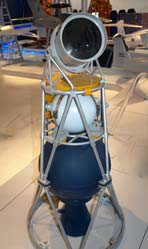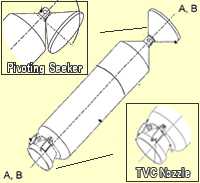
The United States and Israel have initiated development of an upper-tier component to the Israeli Missile Defense architecture, commonly known as ‘Arrow 3’. The development is based on an architecture definition study conducted in 2006-2007, determining the need for the upper-tier component to be integrated into Israel’s Ballistic Missile Defense system. According to Arieh Herzog, Director of Israel’s Missile Defense Program, the main element of this upper tier will be an exo-atmospheric interceptor, to be jointly developed by Israel Aerospace Industries, (IAI) and Boeing.
A recent analysis by U.S. Missile Defense Agency (MDA) assessing the proposed Israeli upper-tier alternatives including Arrow 3 and the planned land-based SM-3, determined that the Arrow 3 alternative may have a reduced life cycle cost and potentially, offer better performance to meet Israel’s requirements, confirmed Lieutenant General Patrick J. O’Reilly, Director of the MDA. “The design of Arrow 3 promisses to be an extremely capable system, mor advanced than what we have ever attempted in the U.S. with our programs” Gen. O’Reilly told the U.S. House of Representatives Armed Services subcommitee for strategic forces. “This has to do with the seekers that have greater flexibility and other aspects, such as propulsion systems- it will be an extremely capable system” he said.
However, General O’Reilly expressed concern about the schedule proposed by the Israelis, “we don’t say they (Israel) can’t do it, we are very supportive of that program, but we are concerned about the schedule they proposed” said Gen. O’Reilly. MDA director said his main concern is the high risk level associated with missile developments, hence, meeting all the program’s goals on the tight schedule proposed by Israel is unlikely. O’Reilly confirmed the agency proposed funding the Israeli upper tier project at a level consistent with historically authorized and appropriated funding levels. To mitigate the Arrow 3 development schedule risk, the U.S. will develop and prepare to deploy a land-based variant of the proven Aegis SM-3 missile to be able to meet Israel’s upper tier requirements.
What Makes the Israeli Technology Unique?
 What are the new technologies that make the Israeli technologies so unique to get such high appraisals from the MDA director? Defense Update has tracked a system described by Dr. Joseph Hasson, chief missile designer at IAI MLM division, presented at a missile defense conference in 2008 and repeated this week in Israel. The presentation provided a hint about the potential paradigm shift for Exo-Atmospheric KV design, employing existing technologies, with simplicity and efficiencies yet unachievable with space vehicles. The new exo-atmospheric Kill Vehicle (KV) was claimed as a patent by Dr. Hasson and Dr. Galya Goldner from IAI MLM, both missile architects at IAI MLM division, which will also develop the Arrow 3.
What are the new technologies that make the Israeli technologies so unique to get such high appraisals from the MDA director? Defense Update has tracked a system described by Dr. Joseph Hasson, chief missile designer at IAI MLM division, presented at a missile defense conference in 2008 and repeated this week in Israel. The presentation provided a hint about the potential paradigm shift for Exo-Atmospheric KV design, employing existing technologies, with simplicity and efficiencies yet unachievable with space vehicles. The new exo-atmospheric Kill Vehicle (KV) was claimed as a patent by Dr. Hasson and Dr. Galya Goldner from IAI MLM, both missile architects at IAI MLM division, which will also develop the Arrow 3.
The IAI team proposed a kill vehicle offering exceptionally large divert capability, meaning the kill vehicle will have exceptional capability to maneuver in space, close-in on a target with high probability of kill, at realistic (very high) closing speeds. Unlike common KVs utilizing space propulsion systems (such as liquid propellant or gas generators), the proposed KV will be propelled by an ordinary rocket motor, equipped with flexible nozzle (vector-thrust). Furthermore, this unique KV will also be fitted with a gimbaled seeker, obtaining hemispheric coverage for the seeker. By measuring the seeker’s line of sight relative to the vehicle’s motion, the kill vehicle would employ ‘proportional navigation’ deflecting the kill vehicle to divert its course and align exactly at target’s fight path, hence achieving an accurate kill even at very high closing speeds and over long distances. Dr. Hasson claims the new concept is relatively simple, reliable and inexpensive and is based on mature technologies. Furthermore, its large divert capability and high agility are contributing to easing the requirements for detection and tracking systems, generally associated with remote-sensor assisted exoatmospheric kills.
Another presentation, by Dr. Idan Paiss, also from IAI MLM, discussed imaging systems in the visible, for ballistic missile interceptors. Dr. Paiss argued that a combined sensor utilizing visible and infrared elements would be suitable for ballistic missile intercept under all lighting conditions, furthermore, when provided with high density matrixes available today, such sensors could provide both target detection, discrimination and tracking as well as assisting line-of-sight measurement utilizing stars tracking.
The new component will also require the integration of longer range detection, tracking and discrimination capabiity, beyond what the Green Pine and Advanced Green Pine radars, employed with the Arrow 2 are providing. Among the advanced sensors considered for Israel’s future multi-tier system, are airborne electro-optical sensors deployed on high flying UAVs and future enhanced Green Pine radars, as well as the AN/TPY-2 radar already deployed in Israel, and operated by U.S. forces.
During the recent ‘strategic dialog’ meeting in Washington, this week Israel was assured the US will continue to support Israel’s missile defense research and development – despite Israeli concerns that economic pressure would lead to cutbacks in the American funding. The teams, headed by US Undersecretary of Defense Michele Flournoy and Defense Ministry Secretary-General Pinchas Buchris, also discussed a number of additional strategic issues. The US intention is to integrate the support for Israeli programs into the US defense budget.
Increasing Cooperation Between U.S. Israel Missile Defenses
 The U.S. Missile Defense Agency is requesting Congress to approve allocation of $120 million in next year’s defense budget for the U.S.-Israeli cooperative missile defense efforts. “The United States and Israel have cooperated on missile defense for over twenty years” Lieutenant General Patrick J. O’Reilly, Director of the Missile Defense Agency said before the House Armed Services Committee Strategic Forces Subcommittee. According to General O’Reilly, U.S.-Israeli collaboration have successfully grown through the years, from early feasibility studies to fully operational fully-operational missile defense architecture that has become fully interoperable with U.S. Ballistic Missile Defense Systems elements. “New joint programs have advanced this cooperation: U.S. and Israeli industrial co-production of Arrow interceptors; the joint Short Range Ballistic Missile Defense Program’s David’s Sling Weapon System; and an initiative to provide Israel an upper-tier defense system.” Said General O’Reilly.
The U.S. Missile Defense Agency is requesting Congress to approve allocation of $120 million in next year’s defense budget for the U.S.-Israeli cooperative missile defense efforts. “The United States and Israel have cooperated on missile defense for over twenty years” Lieutenant General Patrick J. O’Reilly, Director of the Missile Defense Agency said before the House Armed Services Committee Strategic Forces Subcommittee. According to General O’Reilly, U.S.-Israeli collaboration have successfully grown through the years, from early feasibility studies to fully operational fully-operational missile defense architecture that has become fully interoperable with U.S. Ballistic Missile Defense Systems elements. “New joint programs have advanced this cooperation: U.S. and Israeli industrial co-production of Arrow interceptors; the joint Short Range Ballistic Missile Defense Program’s David’s Sling Weapon System; and an initiative to provide Israel an upper-tier defense system.” Said General O’Reilly.
MDA director indicated that significant events planned for this year will demonstrate the combined U.S. -Israeli missile defense capability. Among these are the Enhanced Arrow-2 tested in April 2009, successfully acquiring, tracking, and intercepting a separating target. The test Integrated the Israel based AN/TPY-2 X-Band radar for the first time.
Further integration with U.S. BMDS elements such as the AN/TPY-2, THAAD and Aegis BMD will be performed this summer during the bi-annual ‘Juniper Cobra’ exercise. The ‘David’s Sling’ weapon system developed jointly by Israel MOD and MDA addresses shorter range threats, exceeding the capability of PAC-3 system in certain parts of the envelope.
The first booster fly-out was successfully conducted in February 2009, with additional interceptor fly-outs scheduled later this year. The first intercept test is scheduled to occur in 2010. Additionally, MDA is coordinating with the U.S. Services to identify opportunities for U.S. utilization of the David’s Sling Stunner interceptor.
















